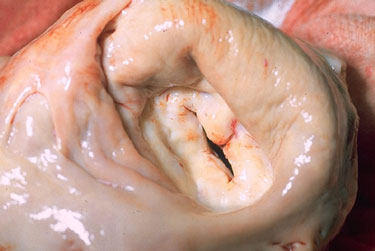Mitral Valve Stenosis
Written By: Adam Pick, Patient Advocate, Author & Website Founder
Page Last Updated: May 10, 2025
The mitral valve is one of four valves in the human heart. Each heart valve allows blood to pass between chambers as the heat beats and then close to keep the blood from flowing back. If the valve becomes narrowed, or stenotic, blood flow is obstructed and the body cannot receive the oxygenated blood needed.
 A Heart Valve with Mitral Stenosis
A Heart Valve with Mitral Stenosis
Mitral Stenosis Symptoms
Mitral valve stenosis can result in various symptoms including:
- Fatigue
- Shortness of breath, especially during exercise.
- Difficulty breathing while in a prone position
- Fluttering or rapid heartbeat can also be a symptom of mitral stenosis.
- Excessive swelling of the ankles or feet
- Frequent upper respiratory infections
- Persistent, heavy cough
- Pain or discomfort in the chest.
Often, however, the patient may display only mild symptoms for many years. Physical stress, such as pregnancy or respiratory infections, can worsen symptoms of mitral valve stenosis.
The patient can also be completely asymptomatic even though the mitral stenosis is severe. It is for this reason that heart valve disease is often referred to as a "silent killer" by leading heart surgeons including Dr. Michael Mack at The Heart Hospital Baylor Plano. Even though the patient experiences no symptoms, the patient's heart can expand resulting in permanent damage, heart failure and death.
Diagnosing Mitral Stenosis
Sometimes, the condition is discovered when the patient visits his physician for a seemingly unrelated illness. The doctor may hear an abnormal heart sound through his stethoscope, leading him to suggest further testing to confirm his suspicion. The abnormal heart sound is a heart mumur.
Patients usually develop noticeable symptoms during their 40s or 50s, but the condition can strike infants and children as well. Younger patients may have no symptoms at all or may experience fatigue or be short of breath when undergoing rigorous activity.
Some mitral stenosis symptoms will not be obvious to the patient. Only a physician will be likely to detect a heart murmur, pulmonary hypertension, congestion in the lungs, arrhythmias, or blood clots.
The gold standard for identifying heart valve diseases, including mitral stenosis, is the use of an echocardiogram. You can learn more about the echocardiogaphy criteria used to evaluate the severity of mitral stenosis here.
Causes of Mitral Stenosis
The leading cause of a stenotic mitral valve is rheumatic fever. Often time, rheumatic fever can develop as a complication of strep throat. If rheumatic fever develops, it can cause scarring of the mitral valve as well as other damage to the heart. Mitral valve stenosis can also be a congenital condition, or one with which a baby is born, although this rarely occurs.
The condition can also be caused by tumors or clots blocking the valve. In older patients, calcium deposits can form around or on the mitral valve. The stenosis can also be caused by radiation therapy and certain medications.
Risks of Mitral Stenosis
There several risks associated with mitral stenosis. Those risks include:
- Heart failure
- Pulmonary edema, or a back up of fluid and blood into the lungs, can also result from mitral valve stenosis.
- Fluids can build up in the abdomen, ankles, or both.
- The heart's left atrium may become enlarged as a result of excessive pressure from the extra work it must due to compensate for the stenotic valve.
- Atrial fibrillation is an irregular heart rhythm that can also lead to the formation of blood clots inside the heart. The clots can cause serious problems if they migrate to another part of the body, such as the brain.
Treating Mitral Stenosis
There are currently no medications that will repair mitral valve stenosis. However, the physician may prescribe drugs that may ease the symptoms, reduce the work the heart must do, or regulate the rhythm of the heart.
Diuretics may be prescribed to help control the accumulation of fluids. Anticoagulants may be used to reduce the chance of clots forming. The patient may also need to take antibiotics as a preventative measure before dental visits to help reduce infection risks from bacteria entering the bloodstream and attacking the heart.
While it is sometimes not necessary to perform any type of procedure to correct a stenotic valve, there are numerous options that can be used. The precise procedure -- either mitral valve repair or mitral valve replacement -- will depend on the patent's overall health and the severity of the damage.
- A balloon valvuloplasty is a non-surgical procedure that involves the introduction of a balloon into the heart via a catheter. After positioning, the balloon is inflated to stretch the opening of the mitral valve. This procedure is typically not used in patients with clots in the heart, since there is a risk the procedure will dislodge the clot.
- Although a mitral valve can sometimes be surgically repaired, patients with the condition may to receive a replacement valve. The replacement valve may be a mechanical or artificial valve, which lasts a long time but require the patient to take anticoagulants for life to prevent clots from forming on the valve. Most patients receive a biological, or tissue, replacement valve. These are most commonly obtained from pigs or cows but may also be obtained from a human organ donor. Patients receiving biological replacement valves will not have to take anticoagulants for an extended period of time, but they may need to have the valve replaced in a few years.
You Might Also Like
To help you learn more about mitral stenosis, here is additional educational information and patient updates:
- Calcified Heart Valve Leaflets
- Mechanical Heart Valve Replacements: What Should Patients Know?
- Chicago Bulls Coach, Fred Hoiberg, Talks About His Mechanical Heart Valve Replacement
- Meet Mitral Valve Patients in Our Community!




